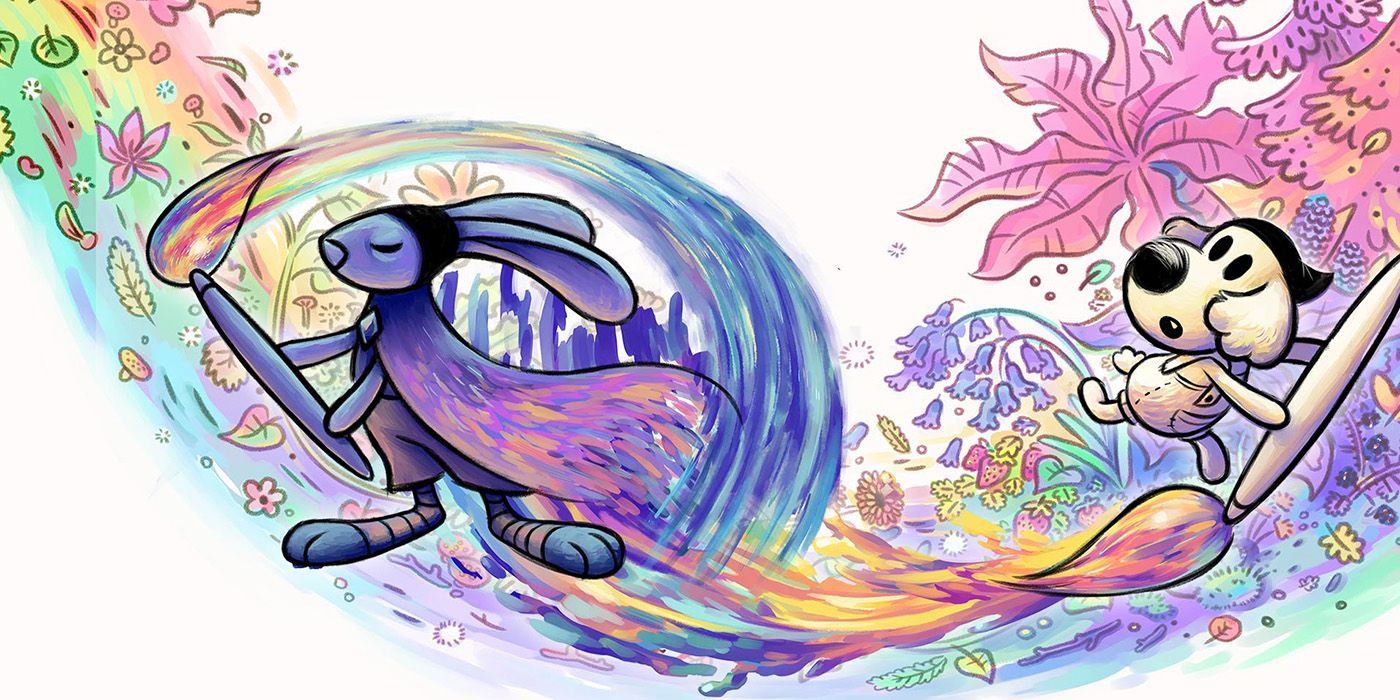
Game Rant recently had a chance to talk with Greg Lobanov, the developer behind whimsical adventure games such as Wandersong and Coin Crypt. His latest project is yet another endearing and cozy game in the form of Chicory: A Colorful Tale, which launches later this year.
Lobanov talked about how Chicory set itself apart from his most recent hit Wandersong, things that players can do in this new adventure RPG, its enchanting soundtrack, how it utilizes the next-gen features of PS5, the future of game pass, and how it could affect future indie games, and much more. The following interview transcript has been edited for clarity and brevity.
RELATED: Chicory: A Colorful Tale Indie Game Coming to PS4 and PS5
GR: Wandersong came back in 2018, right? So since when have you been working on Chicory?
Lobanov: So I actually started prototyping ideas for it a couple of weeks before Wandersong came out. It was a couple of months after Wandersong came out when I actually figured what shape this game was going to be, and exactly how it was going to look and stuff like that. But I was thinking about it for a while.
GR: Chicory feels like a natural evolution of Wandersong. Did you have ideas about it while you were working on Wandersong?
Lobanov: Not exactly. I definitely agree that it’s a natural progression from what Wandersong was, but when I was making Wandersong, I was focused 100% on that game. It was only when it was done and I didn’t have anything to do that I started kind of going off and thinking about other ways to apply some of the same philosophy, design, and stuff. So I won’t say I was thinking about it while working on Wandersong, but yeah definitely a natural progression as the ideas feel related to me.
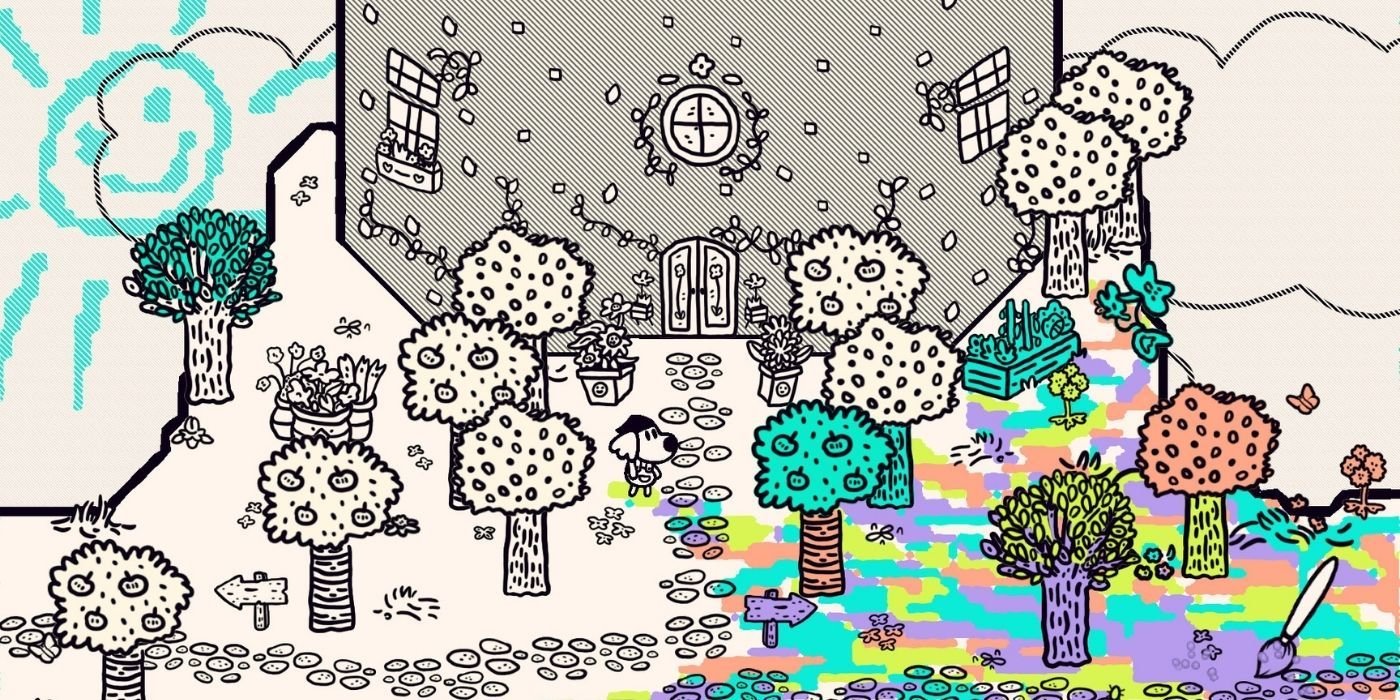
GR: So you were working on this game all alone?
Lobanov: No, that’s not totally true. With Wandersong, I was working with the sound designer and musician. On Chicory, that’s the case as well. I also have been working with a character artist and animator alongside story stuff with Alexis, and an environment artist named Madeline, who drew all the background stuff like the trees, houses, and things like that... that’s all done by her. And it makes a big difference having this many people come into the game. And not even to mention stuff like vocalization and porting and QA all contributed as well.
The team’s actually small, which means that everyone who is working on it does add a lot to the game. It’s like, everyone who worked in it, their personality really does come through, so it’s not just me. I think all the other people who had even a small part in it, their voice kind of comes through as well to the project. I don’t see this as just a reflection of me.
GR: So the title is Chicory, but you play as a cute little dog. What’s the story behind this?
Lobanov: So in this game, there is this magical brush that is used to color the world, and it’s wielded by this legendary famous artist named Chicory. She’s a super famous talented artist, and everyone is a huge fan of her. You actually are her number one fan. At the beginning of the game, she disappears, and all the color of the world disappears with her. You, as her number one fan, decides to take up her brush in her absence and kind of fill in for her while also trying to figure out what happened, so it’s sort of in the vein of how Zelda is not about Zelda or Metroid is not actually about Metroid. This is a game where the title is about the most important secondary character. She’s very central to the story in a lot of ways, so that’s why she is the title of the game.
GR: So Wandersong was about feelings, right? What is Chicory trying to portray?
Lobanov: The emotions in this game are really important as well. I think, if I compare to Wandersong, Wandersong was a really global-minded kind of game that was about the highest stakes imaginable. It was like the apocalypse, traveling down the entire world, and like everyone coming together, and you know, like the end of the universe and all those kinds of stuff which is really cool. This game (Chicory) is a lot more personal and focused. It’s about a much smaller scale problem, and it's really about kind of like the personal relationship between a couple of characters who are dealing with a more immediate issue.
Overall, the direction of the game, I would say Chicory feels way more like a video game than Wandersong did. Wandersong was very story-focused and totally like a linear experience that feels almost closer to like animation or cartoon or a film or something. This game is way more about exploration, kind of like open format type of play, going to places and exploring them and coming back later and seeing how things changed, and developing those kinds of character interactions and gameplay interactions as well. So they are similar, but I would say, really different at the core, like the way the game fundamentally plays out.
GR: What other things do we do in the game aside from coloring?
Lobanov: So the main thing you do all the time is drawing with your brush. What makes the game diverse is the fact that different things in the environment kind of respond to your drawings and art in different ways. In one of the very first areas of the game, for example, there are flowers that you can stand on top of, but if you color them, they shrink down. So by coloring, you’re raising these flowers and you kind of open or close paths to different areas of the map. Later in the game, for example, there's this giant bug that walks around and will eat paint wherever you draw, but you can stand on its back, and it can carry you around, and you can draw plants to carry you to different places.
There is a lot of different ways and different things that interact with your paint and open new paths, or just to play in general. And besides the core exploration and puzzle-solving stuff, this game has a ton of side stuff. For example, there is a camera in this game, and you can take photos, and there are characters who ask you to take photos of certain places or things for them. There are letters you can deliver. Letters open up different kinds of story things that don’t come up if you’re not doing that. There are art classes you can go to where you get the prompts to draw certain things, and then you get like art critique based on what you drew and all kinds of stuff like that.
There are a lot of side things to do in this game. It lends itself way more to that kind of design because it is an open-world game, where every area is where you can come back to, anytime you revisit. So there’s way more than kind of slow-building up, and things that are repeatable that you can do in different ways and different times in any order. There is a lot to do.
RELATED: Top 10 Video Game Indies of 2020
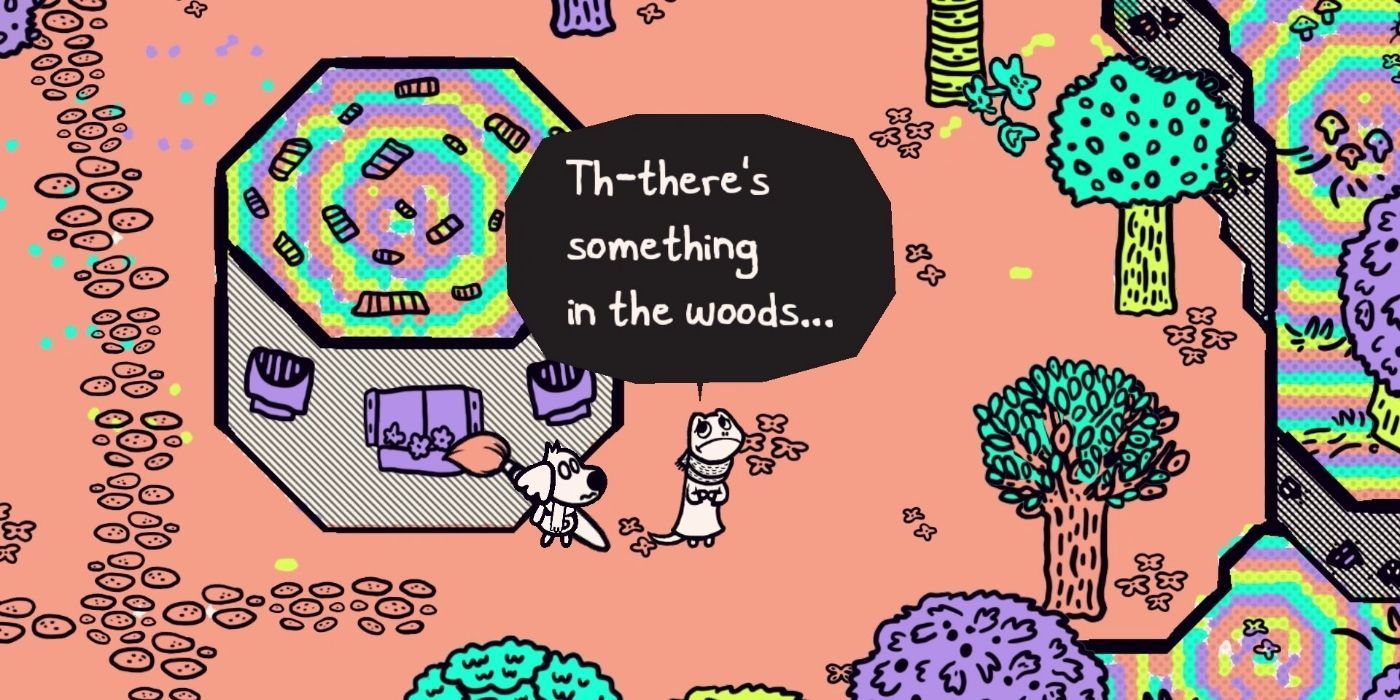
GR: Can you tell me about some of the next-gen features the game is utilizing?
Lobanov: Sure. I have been testing the game on PlayStation 5 especially as it has all the features on it, and I really like playing the game with that controller. My favorite thing about the controllers on PlayStation is actually the touchpad which both of them have. I think painting with a mouse and keyboard is really fun for people who like to draw. The touchpad on the PlayStation gamepads is about as good as I have ever felt while playing a game with a controller but still having all the precision of drawing because you can use the touchpad to move the cursor around, and it feels like finger painting, and you can actually do like really nice drawing with it. I like that a lot.
All the sounds of the paintings come through the controller, especially on the PlayStation 5, which has a really nice vibration. We added a lot of really subtle rumbles and vibrations for painting on different textures or surfaces, and for all the little actions your brush can do, and also the footsteps of the players. All these things can have rumbles. It sounds like it will be crazy, but when you’re playing it feels really nice. It’s a very nice feeling game. The world really feels very alive in your hands. You can almost forget that it’s happening, but it does, I think it really kind of makes the experience feel a little bit more immersive. I really like how that stuff feels and how it's working, and I’m excited for players to check it out with those controllers especially.
GR: Can you tell me about the soundtrack a little bit? I heard some of which is available and it sounds enchanting.
Lobanov: Awesome! I appreciate that. So we are working with Lena Raine, who did the music for Celeste, Guild Wars, and Minecraft. She’s obviously pretty well known. So in the early stages, when we started working on this game, I had assumed that she was going to come and basically make stuff that sounded like what she did in Celeste. I thought that would be great, and what she did is completely different from that, and somehow just as good, if not better, than what she was doing for Celeste. In this game, she focuses a lot more on renaissance and classical kinds of stuff. It feels way more like an RPG. It is like a AAA Square Enix RPG that has a really good soundtrack.
The game is full of personal touch, and I think it adds a lot, for a game like this, that is about exploration, the different areas have really strong themes and different kinds of instrumentations, and a lot of personalities. I have the whole soundtrack...I get to listen to it every day, and I’m really doing that just for fun because I think it’s great. When the soundtrack comes out, I’m sure people are going to go crazy for it. It’s really really fun. There’s also a second album that we are doing for it… that’s kind of like the more relaxed version of the soundtrack… that’s an even easier listening experience and it’s so good...it’s really good. I can’t wait for that to come out as well.
GR: Chicory had a Kickstarter campaign, right? So when did Finji get involved with the game?
Lobanov: Finji got involved with the game in early 2020, I think. They kind of came to us. At the time, because we had done the Kickstarter, and because it had done pretty well, I wasn’t planning to work with a publisher at all, honestly. We were doing okay, and it didn’t feel like we needed the support to do it, but the people at Finji are extremely good at what they do, and they are really talented. I trust them in a way that I don’t really trust, you know, for a game that’s so important to me to give to someone else to handle.
I do have a lot of faith in Finji, and they made a very good offer, and they were very kind to us, and I just knew that it would be better if we work with them... so that’s how it ended up happening. I’m very happy with their involvement, and it’s been awesome working with them. They really understand the game very well, and they don’t really work on many projects, so the things they do work with, they give a lot of attention, and that is really nice.
GR: Game development is a complex process. What advice would you give to someone who is starting game development all alone, just like you did?
Lobanov: I would say, and this is even what I do now really, is to focus on learning one thing at a time. And learning as few things as possible at one time… which is like when you’re working in games, it is actually really hard to do that because making a game involves making art, making sound, making music, doing programming, doing design, and all of that stuff. So it’s really hard to imagine making a game and focusing on just one aspect of it. The reason a lot of people come into games is that they have this vision... you know, like a twenty hours Square Enix RPG with a huge story, and a huge world, they really want to see come to life, and that’s what brings up people into this, and I think that’s awesome.
But I think the best way to get there is really just to focus on learning one thing at a time. So for example, if you wanted to make an RPG... if you make a game, like a really simple-looking game that was focused on doing an RPG design, like a short one-hour RPG, with a really good battle system or something… you’ll get so much more out of that, than spending three years trying to make an RPG with all these other parts and then not finishing it. Before getting to make the games that I’m making now, I made a lot of really small games and just focused on basically learning the smallest things that I could, and I think that helped me a lot in the long run.
RELATED: The 10 Best Square Enix Games That Aren't Final Fantasy
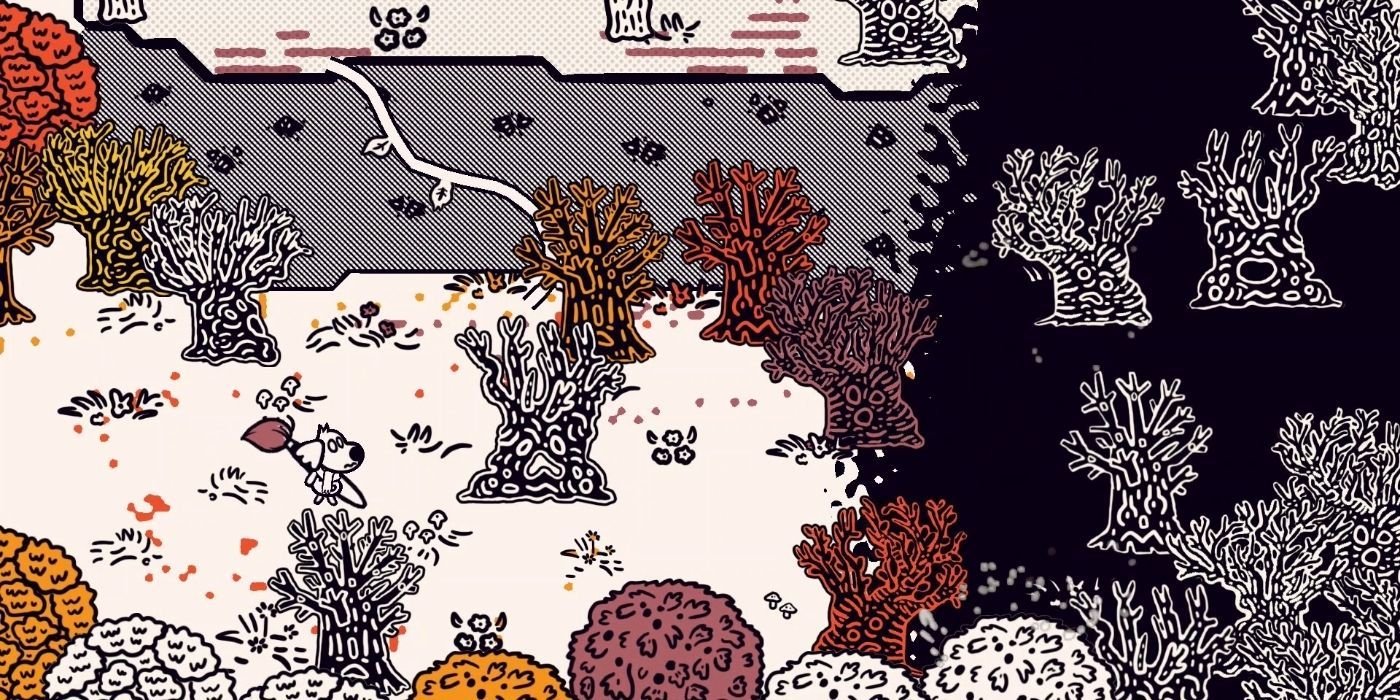
GR: Since you mentioned it, how long is Chicory?
Lobanov: So the playtimes actually vary a lot. We have done playtesting with a lot of people. The fastest I have seen someone play through it is eight hours. The longest I have seen someone play through is closer to thirty-five. This is also like 100% versus just beating the game, but because this game is so open, and because you can spend time drawing, you can spend time doing side content, and exploring the story or not, the way people play this is really different. If you are playing straight to the end, you will get through it quickly. If you are taking your time with it, it can be quite long. I would probably say about twelve to fifteen hours is an average playthrough, but yeah I have seen a huge range honestly.
It’s been interesting trying to design the game, for me too, because people come into this game for very different reasons. Some people just want to play a really good Zelda game. They want to solve puzzles, they want to fight bosses, they want to get to the end of the game, and see what happens, and be done you know… And for that kind of player, you know, we are trying to give them a really good experience.
We have been working on making the puzzles really good, the exploration really good, and all of that, but then some people are totally opposite. They are here to just chill out, take their time and draw everything, and explore the story, and a character will be like, “Oh! There’s a huge problem in this town over here, and you got to help me out right away!” and they be like,” sure,” and get distracted painting the flowers and the trees and the skies and the clouds… draw for an hour and be like," Oh my god I was supposed to be doing something important, but I don’t remember what it was. But whatever, I will just go and talk to this squirrel guy again.” They don’t get anywhere in the game, but they are having a good time the whole time.
So yeah, I tried making a game that is really good for both of these types of people… and that was a kind of fun and interesting challenge. And yeah, I have been excited with the results we have gotten so far, seeing how different kinds of people adapt to it. But I’m definitely very excited to see too when the game comes out, just how all the different ways people are going to approach it.
GR: And it has co-op, right?
Lobanov: Yes, it does have a co-op. The second player can play with a second brush and just draw. Because everything in this game interacts with colors and drawings, you can do basically just about anything that the first player can do except engage in conversations. And it’s surprisingly fun and very lowkey, but it also makes it faster to color the whole screen if you have two people going from the opposite ends. So yeah, I had a lot of fun playing as the second person, and I think it’s a really nice way to hang out together and do stuff.
I’m really excited because of the new Steam remote play together thing they have recently added. It works really well with the game. We didn’t implement online, but if you’re playing on Steam, then you can connect with people remotely and play co-op online through that, and it works surprisingly well. It’s really fun. So I hope lots of people do that. I would love to see people doing that.
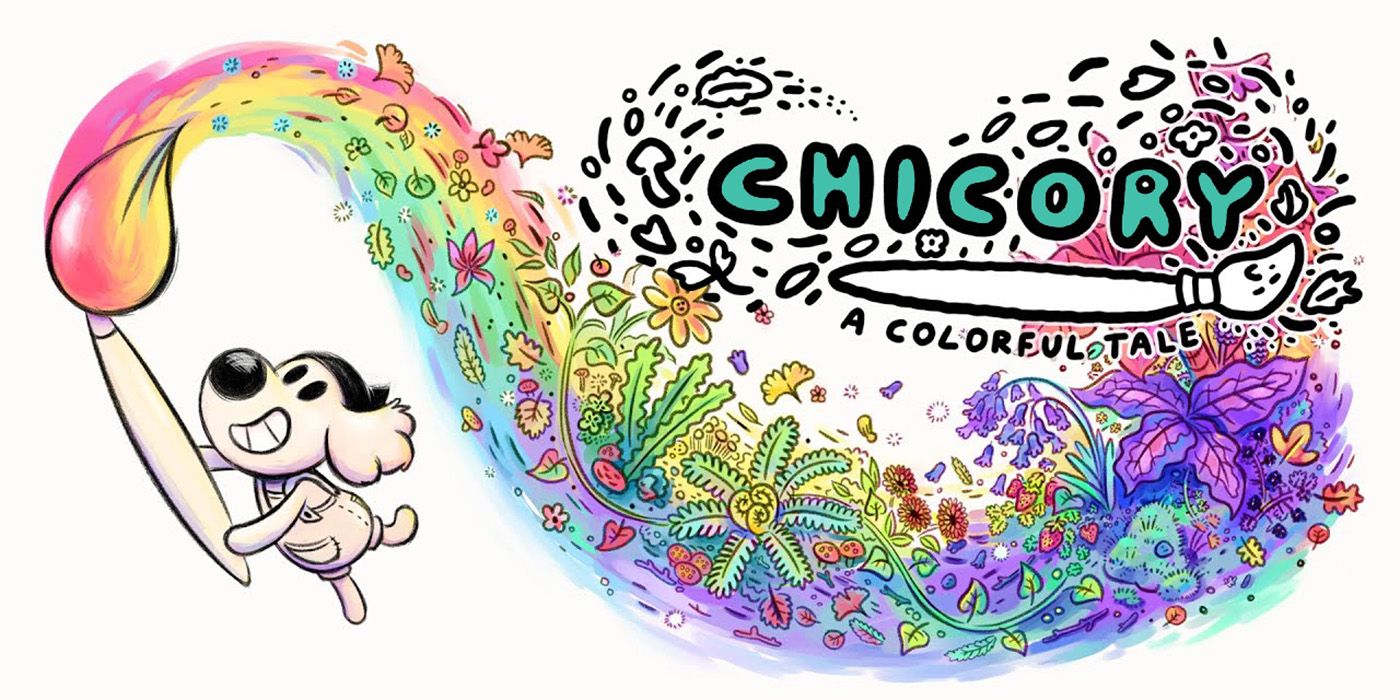
GR: There are a lot of indie games in the market nowadays, and subscription services like Game Pass have been elevating to them some level. Could you tell me your thoughts about the future of Game Pass and how it could affect indie games and stuff?
Lobanov: That’s a big question. So depending on your outlet, there are things to be scared of, and things not to be scared of. I have to say that for Wandersong, for example, we were on Game Pass for that game. Iit was a huge benefit to us because Wandersong was a really niche game that doesn’t look like other games, and so it’s really hard for us to find an audience or something like that, but when people do play it, they really do love it. I think a lot of indie games fall into that category where they are really creative and really different, and that makes it really hard for them to find an audience.
But when they kind of does, it’s really good for them. So yeah, Game Pass was actually awesome for Wandersong. That was like the biggest boost to the audience ever… Hundreds and thousands of people played through Game Pass, and I am sure none of them would have ever played it if not for that. So I’m grateful for that reason.
The scary thing, of course, is that it puts kind of power in the hands of those platforms, so like, at the end of the day, it’s up to Microsoft to decide which games go into game pass, and they are basically curating what games actually gets to the audiences, and who has that access, and you know that can be a bad thing if some games that really deserves that opportunity are left out. I have to say that overall so far I have been excited about the choices Microsoft, for example, has made about the games that do get into game pass. I think they have done a good job at curating. If it remains like an opportunity for smaller games to get in the hands of a bigger audience, then I think that is really sweet. That is kind of the best outcome.
GR: Are there any plans to bring Chicory to Xbox at the moment?
Lobanov: There is nothing that we can announce right now. For now, we are focusing on our launch, which will be on PlayStation, PC, and Mac. Anything else is TBA.
GR: To conclude, would you like to add anything else?
Lobanov: Something that I generally like to bring up because it’s not obvious to people who look at the game out of a glance, this game was designed intentionally for color-blind players, as well as deaf players. It’s definitely designed to be accessible. Half of our QA testers are color blind as well. I know a lot of people who look at this game and see that it is a coloring drawing game, and if they are color blind, they assume that it’s not a game for them, and I just want to like, "Listen, people! That’s a no! And this game is actually color-blind friendly.”
Color is basically not used in puzzle solving and all. You don’t have to know the difference between any color to get to anywhere in the game. The choice of colors is purely aesthetic, it’s just like what color you want to draw with. But they don’t change how the puzzles work or anything. So yeah, I hope the people who have color blindness or any other kind of issues like that feel like this game is for them.
GR: Chicory is targeting an early 2021 release, right? Has the pandemic affected anything?
Lobanov: No. We have been on target for a while actually. On our Kickstarter, we have to give a date for the game. But it looks like we are actually going to have the game come out before or when we said it would on our Kickstarter. I feel like we will be like the first video game ever to do that. I can’t say anything until we actually ship the game and can say we did it, but it looks like we will be able to do that, which is very exciting.
[ End.]

